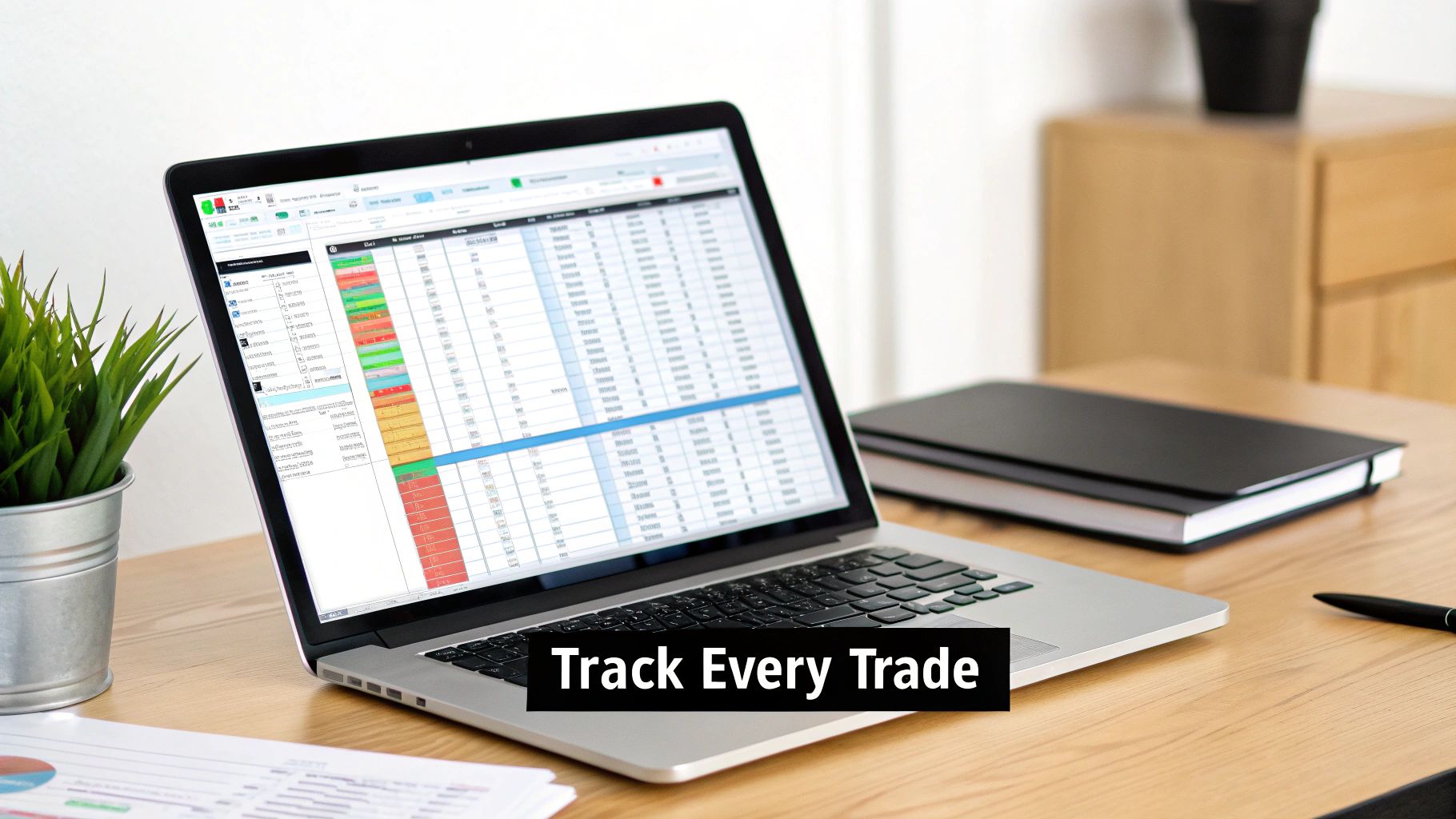An options trading journal is so much more than a spreadsheet. Think of it as your personal system for logging, reviewing, and ultimately refining every move you make in the market. It’s what turns raw data from your trades into genuine insights, helping you build the discipline and long-term perspective needed to separate a good strategy from just getting lucky.
Why Most Traders Fail Without a Journal
Let’s be honest: trading without a journal is like trying to navigate a storm without a compass. It’s a path that often leads to frustration. We’ve all seen traders get trapped in a painful cycle of repeating the same mistakes, letting emotions call the shots, and then wondering why consistent progress feels just out of reach. It’s one of the biggest reasons many aspiring traders struggle to find their footing.
An options trading journal template breaks that cycle. It’s your personal feedback loop, designed for one thing — continuous improvement. The human mind isn’t built to remember past events objectively, especially under the stress of trading. We all fall for hindsight bias, where every losing trade seems obvious in retrospect and every win feels like a stroke of genius. That mental fog makes it impossible to learn from what actually happened.
Overcoming Emotional Decisions
Your memory has a funny way of erasing the gut-wrenching anxiety that made you bail on a winning trade way too early. It also conveniently forgets the FOMO that pushed you into an unplanned, impulsive position. A journal cuts right through that emotional noise.
It forces you to look at the unfiltered reality of your decisions, both the good and the bad. When you log not just the numbers but your rationale and emotional state at the time, you create an honest record. For instance, writing down “Felt anxious about a market drop, so I sold early despite my plan” is a powerful act of self-awareness. This is the first real step toward shifting from reactive gambling to proactive, strategic trading.
A trading journal is the mirror that reflects your true behavior in the market. It doesn’t care about your ego or your excuses; it only shows you the data. Use it to become the trader you want to be.
The image below captures the core struggle so many traders face — that internal battle against emotional decision-making. A journal is the tool designed to help you win it.

This really nails the isolated pressure we often feel as traders. It’s in those moments that impulses like fear and greed can take over unless you have a structured system holding you accountable.
By meticulously keeping a record, you build the discipline needed to navigate the markets with a clearer head. A well-kept journal is a cornerstone of a successful trader’s career. For anyone looking to get this crucial habit started, exploring a daily log book for traders is a great way to build that initial structure.
Building Your Essential Trading Journal Template
Jumping into creating an options trading journal template can feel like a chore, but it’s simpler than you might think. The goal isn’t to track every single data point imaginable. It’s about capturing the right information — the details that actually reveal patterns in your trading. We’re building a tool for actionable insights, not just a graveyard for old trades.

You can build this out in Google Sheets, Notion, or good old Excel. Honestly, the specific tool doesn’t matter nearly as much as your consistency in using it. If you want a deeper dive into a spreadsheet setup, our guide on a trading journal template for Excel is a great place to start. The key is to begin with the basics and only add more complexity when you actually need it.
Let’s start with the absolute must-haves — the core components every options trader should be logging from day one.
Core Data Fields for Every Trade
Think of these as the non-negotiables. They form the backbone of your journal, and without them, you’re flying blind. Each column tells a small part of the story, and together, they paint a complete picture of your trade’s lifecycle.
Here’s a quick look at the essential fields that should be in every template. These data points provide the foundational context for every trade you take.
Core Fields for Your Options Trading Journal
| Field Name | Data Type | Purpose and Example |
|---|---|---|
| Date Entry/Exit | Date | Crucial for tracking performance over time and identifying seasonal patterns. Ex: 10/26/2024 |
| Ticker | Text | The underlying asset you’re trading. Ex: AAPL, SPY |
| Strategy Used | Text | Be specific. This is key for later analysis. Ex: Long Call, Cash-Secured Put, Iron Condor |
| Position Size | Number | The number of contracts you traded. Ex: 5 |
| Entry/Exit Price | Currency | The price per contract you paid (debit) or received (credit). Ex: $2.50 |
| Commissions & Fees | Currency | These small costs add up and directly impact your net P&L. Don’t ignore them. Ex: $3.25 |
| Net P&L | Currency | The final profit or loss after all costs are factored in. This is your bottom line. Ex: $485.50 |
This is a solid start. But to truly get an edge in options, we need to go a layer deeper and track the metrics that make options so unique. This is where you really start to understand your performance.
Options-Specific Metrics That Matter
Options are complex instruments, and your journal needs to reflect that. Adding columns for the Greeks and volatility is what transforms your log from a simple P&L tracker into a powerful analytical weapon. It’s how you start connecting why a trade worked or failed.
Tracking the ‘why’ is infinitely more valuable than just tracking the ‘what.’ Your P&L tells you what happened, but metrics like Implied Volatility and Delta at entry tell you why you even put the trade on in the first place.
Here are the essential options-specific fields you absolutely need to include:
- Strike Price: The price where the option can be exercised.
- Expiration Date: Absolutely crucial for understanding your time horizon.
- Delta at Entry: This measures the option’s sensitivity to a $1 change in the underlying asset’s price. It’s a quick way to quantify your directional assumption. A Delta of 0.70 on a call option means it will gain approximately $0.70 for every $1 the stock goes up.
- Theta at Entry: This is the daily time decay of your position — how much value the option loses each day just from the passage of time. Tracking it helps you understand the “cost per day” of just holding the trade.
- Implied Volatility (IV) at Entry: This tells you how expensive the option was based on the market’s expectation of future price swings. Were you buying calls when IV was sky-high? Or selling premium when it was elevated? Answering this is a game-changer for refining your strategy.
For example, your journal might reveal that buying calls when IV is above 50% consistently leads to losses, even when you nail the direction. That one insight — found by tracking one extra data point — could save you thousands of dollars down the road. This is the real power of a detailed options trading journal.
How to Track Volatility and Market Conditions
If you’re only tracking profit and loss, you’re only seeing half the picture. Options are derivatives, which means their prices are deeply tied to volatility — the market’s built-in fear gauge. If you aren’t logging the market conditions surrounding your trades, you’re missing a critical piece of context.
Adding just a couple of columns to your options trading journal template can completely revolutionize how you see your own performance. This is where you connect your individual trades to the bigger picture and finally understand why certain strategies work beautifully one month and fall apart the next.
https://www.youtube.com/embed/NEakTsocOEU
Why Volatility Is King
The two metrics you need to track are the Implied Volatility (IV) of the specific option you’re trading and the VIX (Volatility Index) at the moment you enter the trade. The VIX gives you a quick snapshot of the market’s overall anxiety level.
Think about it. Selling an iron condor when the VIX is at 15 is a totally different game than selling the exact same setup when the VIX is screaming at 35. In the first scenario, the market is calm. You’ll likely get lower premiums, but your probability of the stock staying within your range may be higher. In the second, things are chaotic. The premiums are juicy, but there’s a much greater risk of a violent market swing blowing right through your strikes.
Your journal will eventually prove what the pros already know — the same strategy can have wildly different outcomes depending on the volatility environment. Your job is to find out which conditions favor your specific edge.
Logging these numbers isn’t just some academic exercise. You’re building a personal database of your performance under different market regimes. After a while, you’ll start to uncover some incredibly powerful, personalized patterns.
Turning Data Into Actionable Rules
Let’s look at a practical example. Say a trader’s core strategy is consistently selling cash-secured puts on blue-chip stocks. After three months of diligent journaling, they decide to filter their trades. They notice something startling: nearly 80% of their losses happened when the VIX was above 30.
That’s a huge insight. The journal didn’t just show them that they lost money; it showed them when and why. The data proved that in high-fear environments, even solid stocks were too prone to sharp drops, easily overwhelming the premium they collected.
Armed with this knowledge, they can create a simple, data-driven trading rule:
- VIX < 30: Execute my cash-secured put strategy as planned.
- VIX > 30: Reduce my position size by 50% or stay on the sidelines and wait for a calmer market.
This is the kind of vital connection you need to make between market conditions and your strategy’s performance. The VIX has been a critical tool for investors since 1993, and its history clearly shows how it mirrors market uncertainty. From 2008 to 2022, the VIX spiked several times, hitting a mind-boggling peak of 80.86 in March 2020 during the pandemic chaos. By adding a VIX column to your journal, you can finally see how your own trading is affected by these macro shifts. You can learn more by checking out CBOE’s volatility data on their official page.
Adding Notes for Deeper Psychological Insights
The numbers in your journal tell you what happened, but the notes are where you figure out why. This is the section of your options trading journal template that gets into the human element — the psychological side that so often makes or breaks a trader’s career.
Without this context, you’re just logging numbers without understanding the behavior that produced them.

We’ve all been there. Placing a trade out of pure FOMO (“fear of missing out”) or holding onto a loser way too long, hoping it’ll turn around. Capturing these exact moments is where the real growth happens. It requires unflinching honesty, but it’s the only way to spot your personal biases and break the cycle of destructive trading habits.
Key Questions to Answer in Your Notes
To get started, just add a few text columns to your template. The goal here is to build a narrative around each trade. Don’t overthink it; just be real with yourself.
Here are a few prompts to guide your note-taking:
- Trade Rationale: Why did I take this trade? Was it a textbook setup from my plan, or was I chasing a hot stock? Be specific. Example: “The stock pulled back to its 50-day moving average, a key support level in my strategy.”
- Emotional State (Entry): How did I feel when I clicked the buy/sell button? Were you calm and confident, or was your heart racing? Example: “Felt rushed because the market was moving fast. A bit of FOMO.”
- Emotional State (During): How did I react when the trade went against me? Did you panic, or did you trust your analysis and stick to the plan? Example: “It tested my stop-loss. I felt anxious but didn’t close the trade because my rules weren’t violated.”
- Post-Trade Reflection: What is the single biggest lesson from this trade? Win or lose, there’s always something to learn. Example: “Lesson: I need to have my profit target defined before I enter, not make it up on the fly.”
Your most expensive trading lessons will repeat themselves until you write them down. Your journal is the tool that ensures you only have to pay for each lesson once.
From Simple Notes to Granular Data
Once you get disciplined with your notes, you can start adding even more granular details. For instance, you could incorporate specific historical options data to add another layer of objective context to your reflections.
Logging metrics like the National Best Bid and Offer (NBBO) or the open interest at the time of your trade can show you precisely how market conditions influenced your execution. This detailed approach helps connect your psychological state with concrete market behavior, turning subjective feelings into data you can actually analyze.
Ultimately, the psychological notes in your journal will become your most valuable asset. They are the raw material for building emotional resilience and discipline. If you’re serious about mastering this side of trading, digging into some of the best books about trading psychology can give you a solid framework for understanding your own behavior.
This is how you move beyond just tracking trades and start mastering yourself.
Analyzing Your Journal to Refine Your Edge
Let’s be honest: a journal you don’t review is just a glorified diary. The real progress happens when you turn that raw data from your options trading journal template into actionable intelligence. This isn’t about running complex algorithms; it’s about carving out some time each week to ask yourself tough questions and let your own trading data give you the answers.
Too many traders are great at logging every detail but never actually close the feedback loop. They record the “what” but completely skip the “why.” A simple weekly review is the bridge between just collecting data and making real, meaningful improvements to your trading plan. It’s how you go from being a passenger to a pilot.
Your Weekly Review Process
Set aside one hour every weekend. Shut down the distractions and open up your journal. The goal here is to sift through your trades and hunt for patterns — both good and bad. Start high-level, then drill down.
Kick things off by asking broad questions to spot the most obvious trends:
- What was my best-performing strategy this week? Filter by strategy (like credit spreads or long calls) and look at the net P&L.
- What was my worst-performing strategy? The answer here can be a real eye-opener. Sometimes the strategy you enjoy trading the most is the one that’s quietly draining your account.
- Did I actually follow my plan? Be ruthless here. Check your notes. Were your entries and exits based on your rules, or did fear or greed take the wheel?
This process isn’t about beating yourself up; it’s about objective discovery. Think like a scientist studying your own performance, where every finding is a clue.
The point of a review isn’t to pat yourself on the back for your winners. It’s to learn from your losers. Your biggest losses hold the most valuable lessons if you’re disciplined enough to look for them.
Digging Deeper into the Data
Once you have the big picture, it’s time to get granular. This is where you can connect the dots between your performance and what the market was actually doing. For example, if a question comes up during your review, you can use historical options data to backtest your assumptions. Companies like OptionMetrics offer incredible datasets going back to 1996, which is perfect for seeing how strategies held up in different market environments. Considering how much options trading volume has exploded, tapping into those historical insights is a huge advantage.
Now, use your journal’s filters to answer the really tough questions:
- Do you consistently lose money trading around earnings announcements?
- Are most of your biggest losses from holding on too long, hoping for a comeback?
- What’s your actual win rate when you sell premium versus when you buy it?
Answering these questions with cold, hard data is how you systematically find and plug the leaks in your trading. This is what transforms your journal from a simple logbook into the blueprint for your future success. It’s how you build a real, sustainable edge over the long term.
Common Questions About Trading Journals
Even with a great template, getting into the rhythm of journaling can bring up a few questions. We get it — the process can feel a little clunky at first. Here are some of the most common things traders ask, with real answers to help you build the habit and make it stick.
What Is the Best Software for an Options Trading Journal?
Honestly, there’s no single “best” software. The best one is the one you’ll actually use consistently.
For most traders, that means starting with a simple Google Sheet or an Excel spreadsheet. They’re free, you can customize them endlessly, and they force you to manually enter every piece of data. That hands-on approach is incredibly valuable when you’re starting out, as it cements the details of each trade in your mind.
Once you have a solid journaling habit and start wishing for more advanced analytics or automatic trade imports, then it might be time to look at a dedicated platform. The key is to start simple. Prove you can stick with the habit first, then think about upgrading your tools.
How Often Should I Update and Review My Journal?
Discipline here is key. The best practice is to log every single trade right after you close it. No exceptions.
The details of the trade — and more importantly, your emotional state — are freshest in that exact moment. If you wait until the end of the day, hindsight bias starts to creep in and you’ll forget the real reason you bailed on that winning trade too early.
Here’s a simple rhythm that works for many traders:
- Log Trades: Immediately after closing each position.
- Weekly Review: Block off an hour on the weekend. This is your time to go through the week’s trades, check your metrics, and really absorb the notes you wrote to yourself.
- Monthly Review: This is for a deeper dive. Look for the bigger patterns that emerge over a few weeks and decide if you need to make any larger adjustments to your overall strategy.
My Journal Shows I’m Losing Money. What Should I Do?
First, take a breath. This is a common and often painful experience for every trader. Your journal is doing its job perfectly by showing you the unfiltered truth you need to improve. This isn’t failure; it’s feedback. Don’t get discouraged —this is the whole point of the exercise.
Now, it’s time to put on your detective hat. Dig into the data and hunt for patterns in your losses. Are most of them coming from a particular strategy, like buying way out-of-the-money calls? Do you tend to give back profits on Fridays?
Your journal is your roadmap to improvement. It doesn’t just show you where you are; it points directly to the roadblocks you need to remove to move forward.
Use your options trading journal template to find the biggest “leaks” in your trading. Then, make a simple plan to fix just one thing at a time. That might mean you stop trading a certain setup for a while, cut your position size in half, or get much stricter with your stop-loss rules. It’s about making small, incremental adjustments based on real data, not emotion.
Ready to transform your trading with a journal that does the heavy lifting for you? TradeReview offers powerful analytics, a visual trade calendar, and automatic broker sync to make journaling effortless. Stop guessing and start analyzing your performance with a tool built for serious traders. Get started for free at TradeReview and build your edge today.


